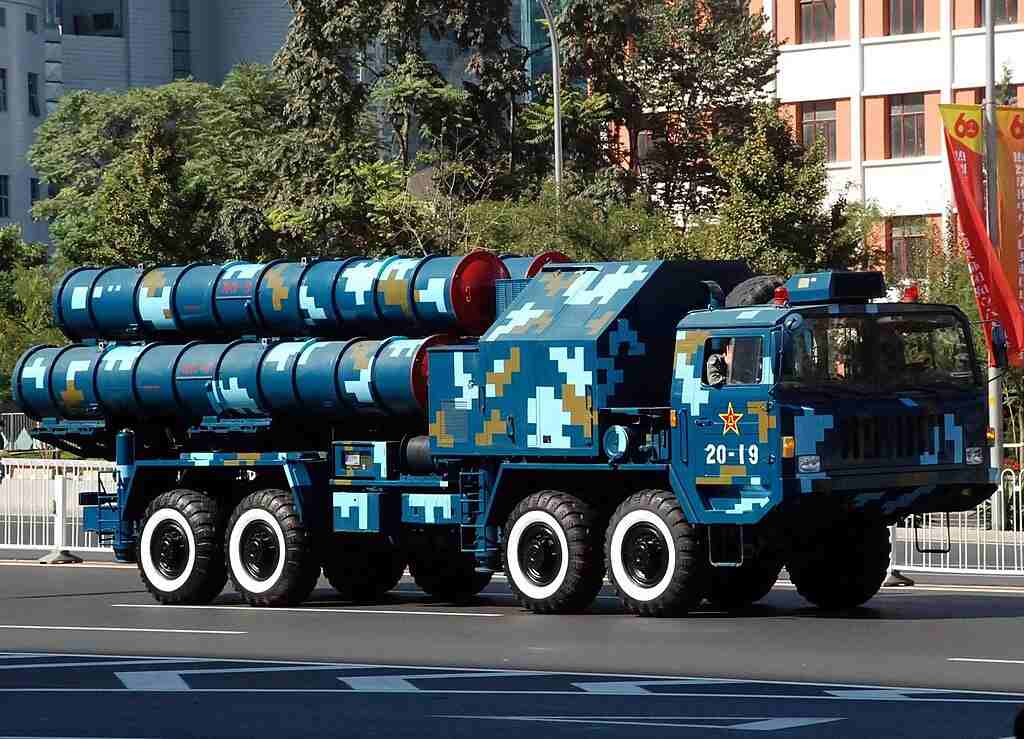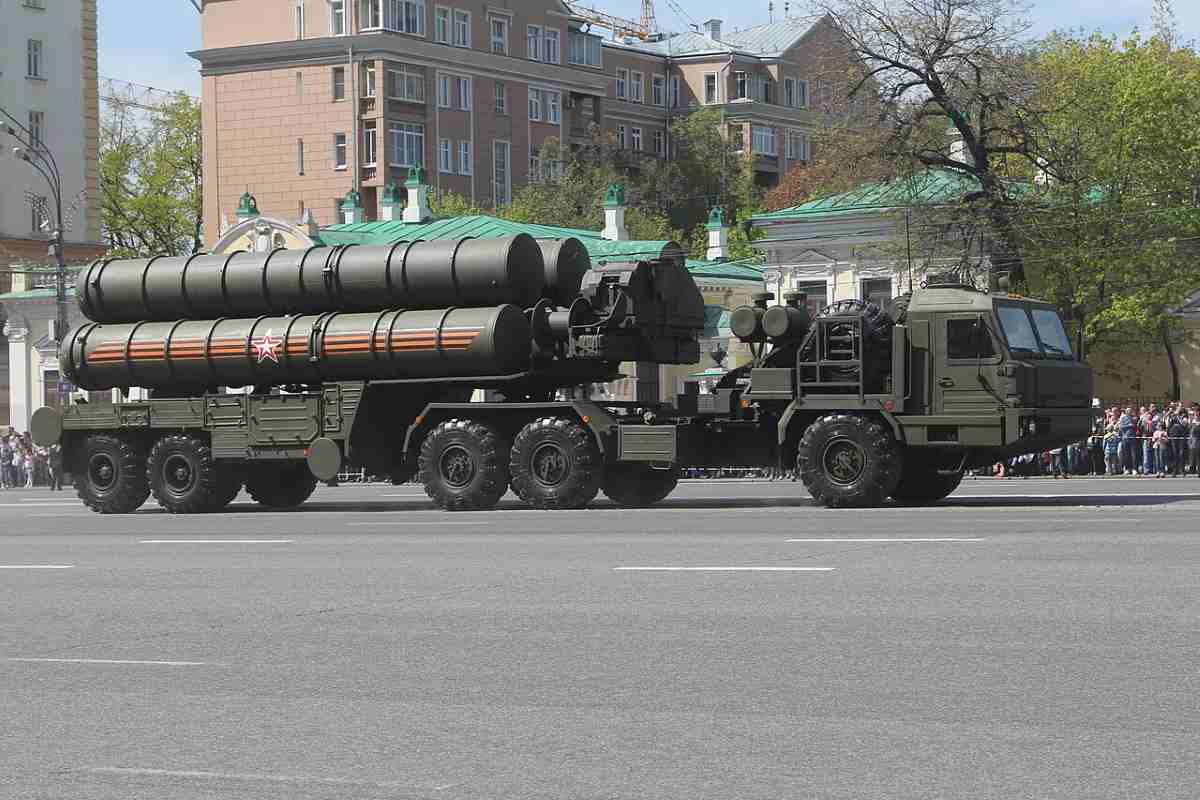The effectiveness of India's S-400 Sudarshan Chakra was seemingly demonstrated on May 8, 2025, with the system reportedly neutralising China's 'advanced' HQ-9 air defence system.
Developed by Russia's Almaz-Antey, the S-400 is a surface-to-air missile system, while the HQ-9 is its counterpart developed by China Aerospace Science and Industry Corporation.
Furthermore, the S-400 air defence system is one of the world's most advanced long-range surface-to-air missile (SAM) systems, capable of engaging multiple targets at distances of up to 400 kilometres.
In contrast, the HQ-9 is the derivative imitation of the S-300, a series of long-range surface-to-air missile systems developed by the former Soviet Union. In this article, we'll take a look at the strengths and weaknesses of Russia's S-400 vs China's HQ-9.
Check Out| What is S-400 Air Defence Missile System? Check Range, Speed and Origin Country
What is the S-400 Air Defence System?
Source: Business Standard
The S-400 air defence system is one of the world’s most advanced long-range surface-to-air missile (SAM) systems, developed by Russia’s Almaz Central Design Bureau. It is named after Lord Vishnu's 'Sudarshan Chakra' because of its swift and precise precision.
On the night of May 7-8, in the Northern and Western parts of the Indian territory, Pakistan attempted to target major cities by attacking with missiles and drones. However, it was intercepted by the S-400 Sudarshan Chakra air defence system, successfully neutralising the threat and protecting Indian civilians.
- Air Defence System: S-400 (SA-21 Growler)
- Manufacturer country: Russia
- S-400 Cost: Estimated around $1.25 billion
- Speed: 17,000 km/h (approximately Mach 14)
- Range: 120-600 km
- Features: Prominent for its advanced radars, long-range missiles, high mobility, adaptability, flexibility, and networking capabilities
15 Interesting Facts About the S-400 Air Defence System
- Do you know that India and Russia inked a deal for five S-400 missile systems in October 2018, a move that strengthened their bilateral relations?
- The S-400 can operate across a wide altitude range, from as low as 10m up to 30 km.
- This system is capable of intercepting ballistic missiles even near the edge of space. Its radar system can detect targets located up to 600 km away.
- The 9M96E and 9M96E2 missiles have an engagement range of up to 120 km, making them suitable for intercepting medium-range threats.
- The 48N6E3 missile offers a range of approximately 250 km and is effective against high-speed aircraft and other missiles.
- The 40N6E boasts the longest range within the S-400 system, capable of engaging targets at distances of up to 400 km, providing strong defence against advanced threats.
- The S-400 has a wide area search and track capability. This means it can simultaneously track up to 300 targets and can engage up to 36 threats at the same time.
- It utilises a diverse suite of radars, including the 96L6E, to provide 360-degree surveillance against various types of targets. Also, it can track stealth aircraft using advanced detection methods.
- The system employs both active and passive guidance to ensure accurate target tracking.
- In terms of mobility, the S-400's components are mounted on wheeled vehicles, allowing for easy transportation.
.jpg)
Source: Army Recognition
- The system can be deployed very quickly, with a setup time of just 5 to 10 minutes. It has a "shoot and scoot" capability, enabling it to fire missiles and then quickly relocate.
- The S-400 offers operational flexibility with both point defence and area defence modes.
- The system can adapt to evolving threats through reprogrammable software.
- It supports multiple missile guidance modes: inertial, active, passive, and satellite.
- The S-400 can be seamlessly integrated with other air defence systems like the S-300, Tor, and Pantsir.
Explore| Military Operations of India: Full List with Names, Locations, and Years
What is China’s HQ-9?

Source: Business Insider
The HQ-9, also known as the Hong Qi-9 (Red Banner-9), is a long-range surface-to-air missile (SAM) system developed by China Aerospace Science and Industry Corporation (CASIC). This missile system incorporates technology from the Russian S-300 and possibly elements influenced by the American Patriot system.
- Air Defence System: HQ-9 (CH-SA-9)
- Manufacturer country: China
- HQ-9 Cost: Estimated around $599 million
- Speed: approximately Mach 4.2
- Range: 120-300 km
- Features: It is designed to intercept various aerial threats, including, Aircraft (fighter jets, bombers, etc.), Cruise missiles, Air-to-surface missiles, and Tactical ballistic missiles. Some variants are reported to have anti-stealth capabilities and limited anti-ballistic missile capabilities.
15 Interesting Facts About the HQ-9 Air Defence System
- Several variants of the HQ-9 exist with varying capabilities, which include the HQ-9 (original), which is the base version and has a reported range of around 120 km.
- The HQ-9A is the upgraded version with improved electronics and software.
- Its HQ-9B is an improved version with an extended range (up to 250-300 km) and possibly a dual seeker (radar and infrared). On the other hand, HHQ-9 is the naval variant for ship-based air defence.
- FD-2000 is an export version, sometimes marketed with anti-stealth capabilities and varying ranges (e.g., 125 km, 250 km).
- The HQ-9P is a customised version for Pakistan with a reported range of 125 km against aircraft.
- The range, although it varies from around 120 km to 300 km, can go up to 30 km against ballistic missiles.
- Additionally, HQ-9 can engage targets at altitudes up to 30 km (for the base version) and reportedly up to 50 km for the HQ-9B.
- It has a maximum speed of around Mach 4.2.
- It typically uses a semi-active radar homing (SARH) system, with some advanced variants possibly incorporating active radar homing or passive infrared seekers.
- The system's radar can track multiple targets simultaneously and engage several threats at once (Has the ability to track around 100 targets and engage up to 6-8 or even more simultaneously).
.jpg)
Source: istock
- The HQ-9's components, including the missile launchers (TELs – Transporter Erector Launchers), radars, and command vehicles, are mounted on trucks for mobility and relatively quick deployment.
- A typical HQ-9 battery includes launch vehicles (usually with four missiles each), various radar vehicles for target acquisition and tracking, command and control centres, and support vehicles.
- It is designed to work within a layered air defence network, potentially integrating with shorter-range systems.
- The primary operator is China (People's Liberation Army Air Force and Navy).
- It has also been exported to several countries, including Pakistan, Algeria, Turkmenistan, Uzbekistan, and reportedly Egypt.
Read On| How Strong is India's Military Strength? A Comprehensive Look
S-400 vs HQ-9: Which One is More Powerful?
| Feature | S-400 Triumf (Russia) | HQ-9 (China) |
| Origin | Russia (Almaz-Antey) | China (CASIC) |
| Max. Range (Aircraft) | Up to 400 km (with 40N6E missile) | Up to 200-300 km (HQ-9B) |
| Max. Range (Ballistic Missiles) | Up to 60 km (estimated) | Up to 30 km (estimated) |
| Max. Altitude | Up to 30 km | Up to 27-30 km |
| Max. Target Tracking | Up to 300 targets | Up to 100 targets |
| Max. Simultaneous Engagement | Up to 36 targets | Up to 6-8 targets |
| Missile Types | 4 (short, medium, long, very long range) | Multiple variants with varying ranges |
| Interception Speed | Up to Mach 14 (with 40N6 missile) | Approx. Mach 4.2 |
| Radar Range | Up to 600 km | Up to 200 km (estimated) |
| Anti-Stealth Capability | Advanced (multi-band radar) | Limited (version dependent) |
| Mobility | Highly mobile | Mobile |
| Deployment Time | 5-10 minutes | Relatively quick |
| Guidance Modes | Inertial, active, passive, satellite | Semi-active radar homing (SARH), possibly active/passive IR in later versions |
| Integration | Seamless with other Russian systems | Designed for networked defense |
Power Comparison Summary:
.jpg)
Source: National Herald
- Superior Range: The S-400 boasts a significantly longer engagement range against both aircraft and potentially ballistic missiles, especially with its longest-range 40N6E missile.
- Enhanced Radar Capabilities: Its radar has a much greater detection range and can track a significantly higher number of targets simultaneously.
- Greater Engagement Capacity: The S-400 can engage a substantially larger number of targets at the same time, making it more effective against saturation attacks.
- Higher Interception Speed: The S-400's missiles have a considerably higher top speed, increasing the probability of a successful interception against fast-moving threats.
- Advanced Anti-Stealth Features: The S-400's multi-band radar systems offer a better capability to detect and track stealth aircraft compared to the HQ-9.
- More Missile Options: The availability of four distinct missile types with varying ranges provides the S-400 with greater flexibility in dealing with a wider spectrum of threats at different distances.
Source: armadnizpravodaj.cz
While the HQ-9 is a capable long-range air defence system and serves as a crucial component of China's and other nations' defence networks, it generally lags behind the S-400 in key performance metrics.
Therefore, the S-400 air defence system is more powerful than the HQ-9, representing a more advanced generation of air defence technology, offering a broader and more robust defensive umbrella.
What's Next| India vs. Pakistan Military Strength: A Detailed Analysis of Army, Navy and Air Force

.JPG)
Comments
All Comments (0)
Join the conversation